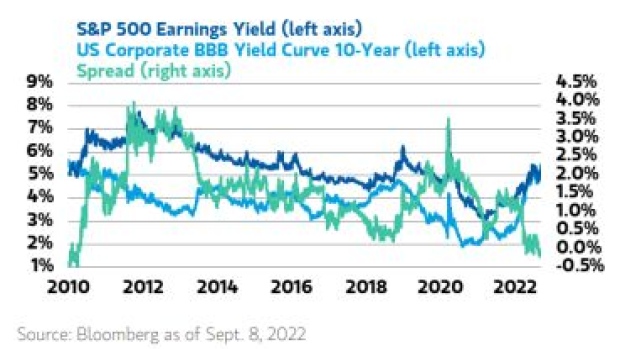Sep 12, 2022
Credit Calculus Turns Against Stocks With Yield Edge Over Bonds Vanishing
, Bloomberg News

(Bloomberg) -- A valuation bulwark that had supported stocks relative to credit is starting to erode.
The model compares profit streams with interest rates. It shows the S&P 500’s earnings yield, the reciprocal of its price-earnings ratio, at around 5% now trails the rate from a lower tier of 10-year investment-grade bonds for the first time in more than a decade, according to Morgan Stanley data.
The last time the spread was negative in 2010, the S&P 500 went flat the following year, halting a two-year rally.
“Because the spreads on investment grade corporate bonds have recently widened, stocks no longer look attractively priced versus comparable corporate debt,” Lisa Shalett, chief investment officer of Morgan Stanley Wealth Management, wrote in a note to clients.
The data highlights a potentially weakening foundation for stocks at a time when the Federal Reserve is hiking interest rates at the fastest pace in decades while analysts are slashing their estimates on corporate earnings. Since the start of July, expected profits from S&P 500 companies for the current quarter have dropped by roughly $3 to $56.62 a share, data compiled by Bloomberg Intelligence show.
While the downgrade sets a lower bar for firms to clear when they start reporting next month, it also highlights some worrisome trends for stock bulls. After years of near-zero interest rate policy from the Fed pushed investors into riskier assets, that mantra -- sometimes abbreviated TINA, for “there is no alternative” -- is losing sway with the central bank poised for another jumbo rate hike later this month.
Valuation is a famously poor timing tool, and investors are showing themselves capable of brushing aside gloomy outlooks -- for now. Stocks just snapped three weeks of declines. Up almost 1% as of 2:20 p.m. in New York, the S&P 500 was heading for a fourth straight advance -- the longest winning streak in two months.
The gains came as investors who had cut equity exposure were forced to chase rallies with the market bouncing back. From short sellers to rules-based traders, bears were rushing for cover, adding fuel to the advance.
The resilience in stocks is why Morgan Stanley’s chief US equity strategist, Mike Wilson, faced some push-back when visiting clients in London last week.
“There’s reluctance to embrace the bearish view because of recent positioning-driven squeezes,” Wilson wrote in a separate note.
To be sure, the signal sent by the study depends on which fixed-income rate is plugged in for comparison. Morgan Stanley looked at corporate bonds rated BBB. A comparison to 10-year Treasuries shows the message is less straight forward. Going by that, stocks are still moderately expensive relative to the history of the post-crisis bull market, but quite cheap compared with the longer historical series -- a period in which bond yields were generally much higher.
Morgan Stanley’s approach on stock-bond valuation is a version of something known as the Fed model that is the subject of a fair amount of debate among analysts. While the comparison provides a handy way to gauge relative value, Ed Yardeni, who coined the term “Fed Model,” has pointed out that the framework does not take into account the role of inflation. Corporate earnings and bond yields aren’t the same -- they move with different volatility and different sensitivity to inflation, one of the most important factors in today’s market dynamics.
Generally, inflation eats into future returns from fixed income. But for equities, the impact is more nuanced. If companies can pass higher prices to end users, that can help boost profits. In that sense, a case can be made that equity risk premium, or the yield gap over bonds, stays subdued.
“The argument is that stocks are a better asset to own than bonds in such a regime and therefore deserve a lower risk premium,” Wilson said. “While we agree with the premise of that argument and, in fact, used that exact statement to go all in on stocks in late March 2020, we don’t think it’s an appropriate rationale today if one believes we are entering a significant cyclical downturn for earnings forecasts.”
©2022 Bloomberg L.P.






